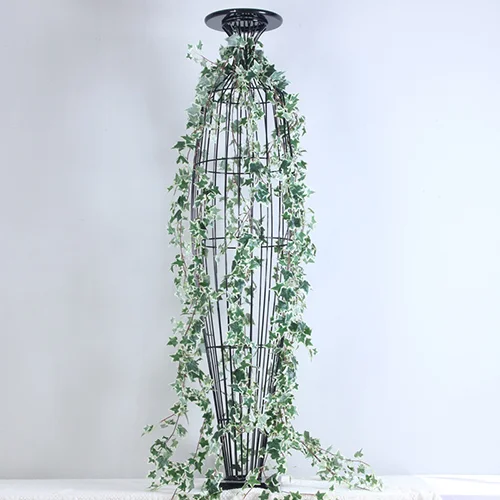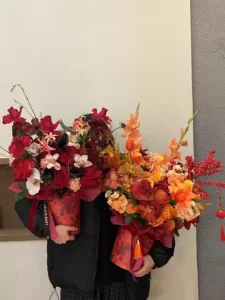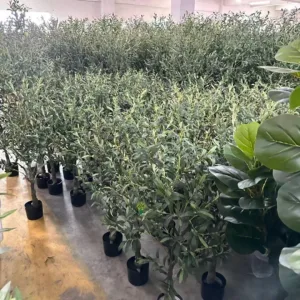Versatile and lifelike creations bring the beauty of nature indoors, offering a maintenance-free solution for those who crave the charm of ivy without the upkeep. artificial ivy vines are the perfect botanical accessory, providing endless possibilities for creative and elegant decor.
Step into a world where nature meets creativity as we explore the enchanting realm of artificial ivy vines.In this upcoming blog post, we’re excited to share 12 innovative ideas and expert tips on transforming your living spaces with the timeless beauty of faux greenery.
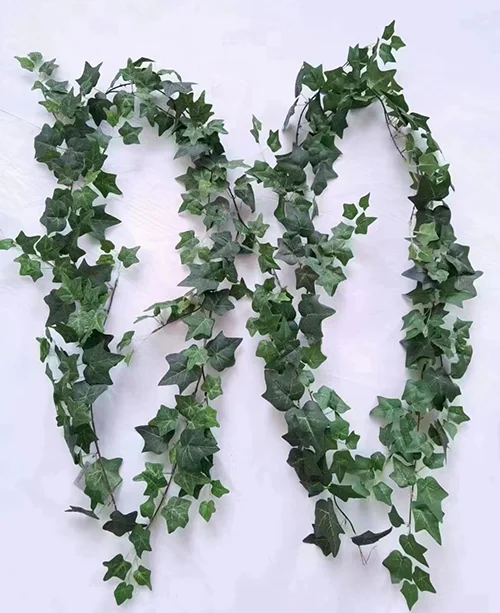
What are Artificial Ivy Vines made of?
Artificial ivy vines are typically crafted from various materials to achieve a realistic appearance. The primary components include:
1. Polyester or Silk Fabric:
• The leaves of artificial ivy vines are often made from polyester or silk fabric. These materials offer a natural look and feel, contributing to the lifelike appearance of the faux vines.
2. Plastic or PVC:
• The stems and structure of artificial ivy vines are commonly constructed using plastic or PVC (polyvinyl chloride). These materials provide durability and flexibility while keeping the vines lightweight.
3. Wire Frames:
• Internal wire frames are used to give structure to the vines, allowing them to be shaped and arranged according to various decorative needs. The wire frames also contribute to the vines’ ability to hold their form.
4. Natural Coloration and Detailing:
• Manufacturers often employ advanced printing techniques to replicate the natural colors, patterns, and detailing found in real ivy leaves. This attention to detail enhances the authenticity of the artificial ivy.
These materials are chosen for their durability, flexibility, and ability to mimic the appearance of real ivy. The combination of fabric, plastic, and wire allows artificial ivy vines to withstand various environmental conditions and maintain their aesthetic appeal over time.
How to decorate with artificial ivy vines
From crafting your own DIY topiaries to creating stunning green walls, get ready to discover how artificial ivy vines can add a touch of elegance and nature-inspired charm to your home or special events.
1. Faux Green Wall:
• Create a stunning green wall by draping artificial ivy vines on a trellis or wall grid. This adds a touch of nature to indoor spaces. Transforming the space into a lush oasis is easier than ever with the captivating allure of artificial ivy vines fashioned into a faux green wall and experience the lushness of greenery throughout the seasons.
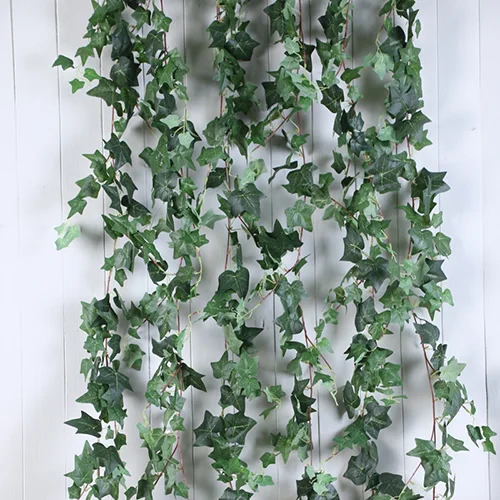
2. Table Centerpiece:
• Arrange artificial ivy vines around candles, lanterns, or other centerpieces for a rustic and elegant table setting.
3. Hanging Gardens:
• Suspend ivy vines from the ceiling to mimic a hanging garden. This works well in areas with high ceilings and adds a whimsical touch.
4. Ivy Curtain:
• Hang strands of artificial ivy vines to form a decorative curtain. This can be a beautiful backdrop for events or a unique room divider.
5. Ivy Wreaths:
• Craft wreaths using artificial ivy to adorn doors, windows, or even as wall decorations. Add bows or ribbons for a festive touch.
Design Options:
1. Full and Lush:
Choose a wreath with a dense arrangement of ivy vines for a full and lush appearance. This style is perfect for creating a statement piece on your front door or as a centerpiece indoors.
2. Simple and Elegant:
Opt for a more understated design with a minimalist arrangement of ivy vines. This style adds a subtle touch of greenery to your space and complements various decor themes.
3. Seasonal Accents:
Enhance the versatility of your ivy wreath by adding seasonal accents such as faux flowers, berries, or decorative ornaments. This allows you to transition the wreath seamlessly from one season to another.
Placement and Display:
1. Front Door Welcoming:
Hang the ivy wreath on your front door to create a warm and inviting entryway. Pair it with a festive bow or ribbon for a personalized touch during special occasions.
2. Indoor Elegance:
Gracefully adorn interior doors, walls, or mirrors with ivy wreaths. Their lightweight design allows for easy hanging, instantly transforming any room with a touch of natural charm.
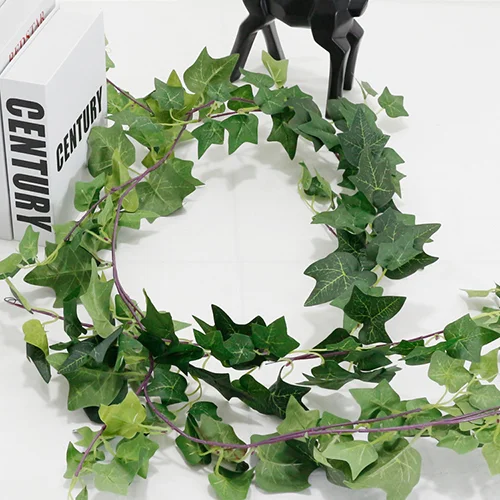
6. Framed Ivy Art:
• Place artificial ivy vines within picture frames to create botanical art pieces. Hang them on walls for a subtle and artistic green accent.
7. Ivy-Adorned Furniture:
• Wrap artificial ivy around furniture, such as chair backs or table legs, to add a touch of greenery to your existing decor.
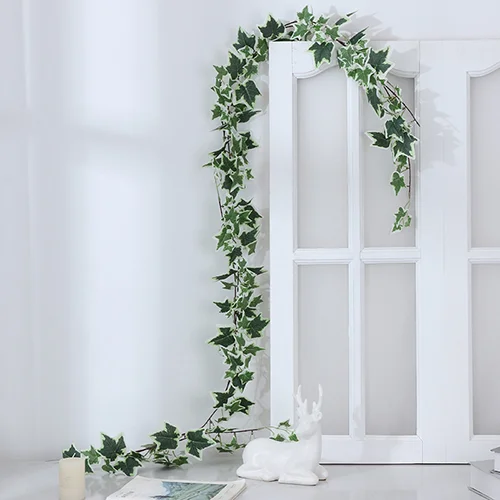
8. Terrarium Enhancement:
• Place artificial ivy vines inside terrariums or glass containers to create a low-maintenance and visually appealing mini garden.
9. Outdoor Balcony or Patio Decor:
• Use artificial ivy to decorate outdoor spaces by wrapping it around railings, creating ivy garlands, or draping it over pergolas.
Crafted with durability in mind, artificial ivy vines for outdoor use feature high-quality materials. The leaves are often made from weather-resistant polyester or silk fabric, while the stems are crafted from sturdy plastic or PVC. This construction ensures resilience against varying weather conditions.
Design Options:
Vertical Greenery:
Create a vertical garden on your balcony or patio by arranging artificial ivy vines along railings or walls. This not only adds a touch of nature but also provides privacy and a sense of seclusion in outdoor spaces.
Pergola Paradise:
Drape artificial ivy vines over pergolas to transform them into captivating green canopies. This not only enhances the aesthetic appeal but also provides shade and a serene ambiance for outdoor relaxation.
Container Gardening:
Place potted plants or flowers surrounded by artificial ivy vines to create a picturesque container garden on your balcony. The ivy serves as a delightful frame, adding a touch of sophistication to your outdoor oasis.
Seasonal Accents:
Elevate your outdoor decor by incorporating seasonal accents into the artificial ivy vines. Integrate faux flowers, berries, or decorative elements to celebrate different seasons and occasions.
10. Event Backdrops:
• For events and celebrations, use artificial ivy vines to create enchanting backdrops for photo booths or ceremony spaces.
11. Ivy in Lanterns:
• Place artificial ivy inside decorative lanterns for a charming and natural look. This works well both indoors and outdoors.
12. DIY Ivy Topiaries:
• Craft your own ivy topiaries by shaping artificial ivy into ball or cone shapes. Place them in decorative pots for an instant green accent.
Artificial Ivy Vines installation guide
How to stick fake ivy to the ceiling?
Adhesive Hooks: • Use adhesive hooks designed for ceilings. Ensure they are suitable for the weight of your fake ivy. Clean the ceiling surface before applying the hooks to ensure good adhesion. Hang the ivy strands onto the hooks, allowing for a secure and temporary attachment.
To stick fake ivy to the ceiling, you can use a few different methods depending on the type of ceiling and the desired level of permanence. Here are three common approaches:
1. Adhesive Hooks:
• Use adhesive hooks designed for ceilings. Ensure they are suitable for the weight of your fake ivy. Clean the ceiling surface before applying the hooks to ensure good adhesion. Hang the ivy strands onto the hooks, allowing for a secure and temporary attachment.
2. Double-Sided Tape or Adhesive Strips:
• Double-sided tape or adhesive strips can be effective for lightweight artificial ivy. Cut the tape into small pieces and attach it to the back of the ivy strands. Press the ivy onto the ceiling, making sure it adheres firmly. This method is suitable for temporary or short-term decorations.
3. Ceiling Hooks and Fishing Line:
• Install small ceiling hooks at even intervals on the ceiling. Use clear fishing line to tie the artificial ivy to the hooks. This method gives the illusion of the ivy hanging freely and can be a more secure option for heavier vines.
How to attach fake ivy to a fence?
Attaching fake ivy to a fence can be a creative and aesthetically pleasing way to enhance your outdoor space. Here’s a simple method using zip ties:
Materials Needed:
• Fake ivy strands
• Zip ties (also known as cable ties)
• Fence
Steps:
1. Position the Ivy:
• Determine where you want to attach the fake ivy on the fence. Lay out the ivy strands along the desired area to plan the arrangement.
2. Secure One End:
• Start at one end of the fence. Bundle a few strands of fake ivy together and secure them to the fence using a zip tie. Fasten the zip tie tightly but not so much that it damages the ivy.
3. Wrap and Attach:
• Wrap the fake ivy around the fence, overlapping the strands as you go. Use additional zip ties along the way to secure the ivy to the fence. Make sure to distribute the weight evenly to prevent sagging.
4. Secure the Other End:
• Once you reach the other end or the desired length, secure the final section of the fake ivy with another zip tie. Trim any excess zip tie length for a neat appearance.
5. Adjust and Fluff:
• After securing the ivy, step back and assess the overall appearance. Adjust the positioning of the ivy strands as needed to achieve a balanced and natural look. Fluff and arrange the leaves to create a lush appearance.
Tips:
• Use green or black zip ties to blend in with the fake ivy and fence. • Ensure the fence surface is clean before attaching the fake ivy to improve adherence. • Consider the weight of the artificial ivy; heavier vines may require additional zip ties or support. • If your fence has larger gaps, you might want to use multiple zip ties to secure the ivy more effectively.
This method is straightforward, temporary, and doesn’t damage the fence. It allows you to easily remove or rearrange the fake ivy as desired.
How do you get fake vines to stay on the wall?
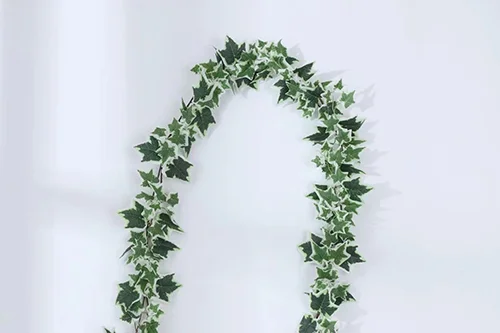
Securing fake ivy vines to a wall can be accomplished using a few methods, depending on the wall surface and your preferences. Here’s a simple way using removable adhesive hooks:
Materials Needed:
• Fake ivy vines
• Removable adhesive hooks
• Wall
Steps:
1. Clean the Wall:
• Ensure the wall surface is clean and dry. Wipe away any dust or dirt using a mild cleaner. This helps the adhesive bond more effectively.
2. Position the Ivy:
• Lay out the fake ivy vines along the wall to plan the arrangement. This step will help you visualize the final look and decide on the placement.
3. Install Adhesive Hooks:
• Install removable adhesive hooks onto the wall at regular intervals. The number of hooks you need will depend on the length and weight of the fake ivy. Follow the instructions provided with the hooks for proper installation.
4. Secure the Ivy to Hooks:
• Attach the fake ivy vines to the adhesive hooks. This is typically done by draping the ivy over the hooks or looping them through, depending on the design of the hooks and the flexibility of the vines.
5. Adjust and Arrange:
• Step back and assess the arrangement. Adjust the positioning of the ivy vines to create a balanced and visually pleasing display. Arrange the leaves for a natural and lush appearance.
Tips:
• Choose removable adhesive hooks designed for the weight of your fake ivy to ensure a secure hold.
• Consider the flexibility of the fake ivy vines. Some varieties are more pliable and easier to work with when looping around hooks.
• Test the adhesive hooks in a small, inconspicuous area first to ensure they won’t damage the wall finish.
• If your wall surface allows, you may also use double-sided tape or removable mounting strips to secure the fake ivy.
This method provides a temporary and damage-free way to display fake ivy on the wall. It allows for easy removal and repositioning, making it a versatile solution for changing decor arrangements.
Maintenance tips
How to make artificial ivy vines not smell
If your artificial ivy vines have an unpleasant odor, don’t worry, it may because of the glue,you can take several steps to address the issue:
1. Air Out the Ivy:
• Unpack the artificial ivy and allow it to air out in a well-ventilated area. Sometimes, the odor is a result of being stored in packaging, and airing it out can help dissipate the smell.
2. Use Fresheners:
• Place air fresheners or odor-absorbing products near the artificial ivy. Consider using natural options like activated charcoal, baking soda, or potpourri to help neutralize any unwanted odors.
3. Fabric Freshener Spray:
• Lightly spray the artificial ivy with a fabric freshener or a mixture of water and a mild fabric spray. Be sure to test a small, inconspicuous area first to ensure the spray doesn’t affect the color or material.
4. Vinegar Solution: • Mix a solution of equal parts water and white vinegar. Lightly spray or dab this solution onto the artificial ivy using a cloth. Vinegar is known for its ability to neutralize odors. Again, test a small area first to avoid any adverse effects.
5. Sun Exposure: • If the artificial ivy is made of materials that won’t be damaged by sunlight, consider placing it in direct sunlight for a few hours. Sun exposure can help eliminate odors.
6. Essential Oils: • If the artificial ivy is odor-resistant, consider adding a pleasant scent using essential oils. Dilute a few drops of essential oil in water and lightly spray or mist the ivy.
7. Baking Soda Absorption:
• If the artificial ivy is flexible, you can sprinkle baking soda on it and let it sit for a few hours. Shake or brush off the baking soda to remove any remaining residue.
8. Contact the Manufacturer:
• If the odor persists and the artificial ivy is relatively new, consider reaching out to the manufacturer. They may provide guidance or offer a solution if the smell is a result of the manufacturing process.
Always be cautious and test any cleaning or deodorizing method on a small, inconspicuous area first to ensure it doesn’t damage or discolor the artificial ivy.
From above article, have you got the point of artificial ivy vines decoration? Plantifya, Artificial Ivy Vines wholesale from China, provide muti-size and many styles of artificial ivy vines. Explore our diverse selection of artificial ivy today and embark on a journey of timeless elegance.
